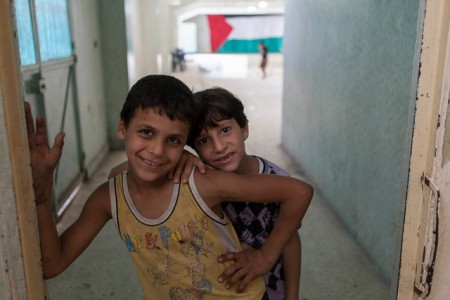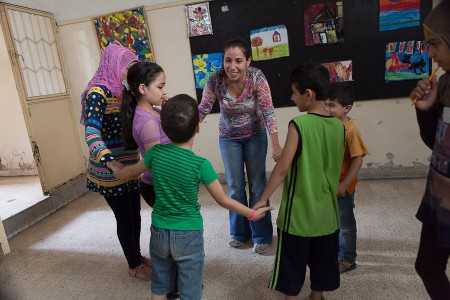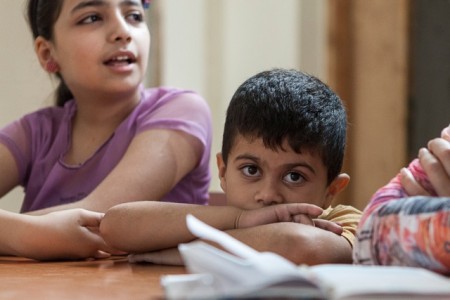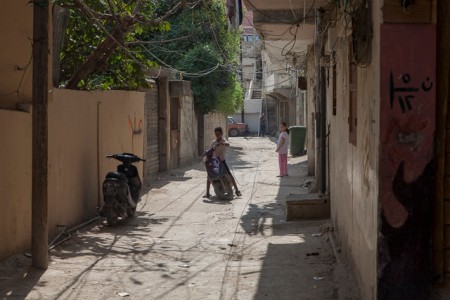Doubly homeless
Syria's Palestinians in Lebanon

Lebanon has now passed the 100,000 mark of Syrian refugees in the country. But one group is sadly forgotten: Syrian Palestinians. Having fled the fighting, they now live in Lebanon’s Palestinian camps, where they rely on help from local organisations. Many have come to Ain el-Hilweh, in the middle of the coastal city of Saida.
The streets of Ain el-Hilweh are busy. Old cars, mothers with their kids and young guys on motorbikes all try to make their way through the narrow roads. Small shops line the streets: old women sell their vegetables next to cellphone vendors and minimarts. But this familiar street life takes place against a run-down setting: Ain el-Hilweh is the largest, and one of the most overcrowded, of Lebanon’s 12 Palestinian camps. The camps, set up originally to care for those who fled Palestine after 1948, are now permanent homes for hundreds of thousands of people. Most residents live in poor conditions, without proper access to basic services, discriminated against by Lebanese society.
This is where the Syrian Palestinian families have found temporary homes. Ali Salam, project manager for the local organisation Naba’a, says that at least 400 families have come to Ain el-Hilweh alone. “In each family, there are maybe three or four people. Most live with relatives or people they know in the camp — often as many as 10 people in one room.”
For many families, fleeing the inescapable reality of war in Syria, only meant facing another harsh reality in neighbouring Lebanon. Assistance has been slow: all UN assistance to refugees is funnelled through its refugee agency, the United Nations High Commissioner for Refugees (UNHCR). Except assistance to the Palestinians; a separate agency, the United Nations Relief and Works Agency for Palestine Refugees in the Near East (UNRWA), was set up in 1949 with the mandate to provide for them. Today, when international donors earmark money for the Syrian refugees, none of those funds reach the Palestinians.
Instead, organisations in the camps do what they can to support the refugees and the local families who house them. The international NGO War Child, in partnership with Naba’a, runs programmes with the children to help them settle in the new environment. Manal Eid is programme development manager for War Child. “It’s very hard for these kids. They have experienced different situations of violence and abuse. We try to build up their strength and hope and produce possibilities for them to heal from their emotional and psychological wounds.”

War Child’s activities take place in a building just off the main thoroughfare in Ain el-Hilweh. The place, which is big but very simple, is full of children, both local kids and refugees from Syria; the idea is to integrate the newcomers and help them find new friends in the camp. In one room, a group of children around a large, round table discuss violence — “Emotional violence is the worst, it hurts more than when someone beats you” — and how to counter it.
At another table sits 11-year-old Hana, who fled Syria with her family only a few weeks earlier. She speaks about her trip to Lebanon: Together with her mum and siblings, she had to cross the border by foot after the driver had been killed at a checkpoint. “Now we live in a house that belongs to a relative. But I’m not happy here, I have no friends. I would like things to go back to how they used to be, so that I can return and go to school,” she says.
Saleh, a 7-year-old boy, sits next to Hana. He speaks with simple, short sentences, relating what happened before he came. “My house was hit by a bomb and split in two, so we couldn’t live in it anymore. That’s why we came here. But I dream every day of going back, and for our house to be OK.” He’s sad, he says, that he cannot go to school in the camp. “I went to the school, twice, but they said I couldn’t go. So then I told them: If I can’t register here, I’ll go to another school!”
An important part of War Child’s work is having the children talk about what they’ve been through. A psychologist and a team of social workers meet with the kids and help them deal with their difficult experiences. Ruwaida Ismail, War Child’s psychiatrist, meets refugee children every day. Most of the ones newly arrived from Syria carry traumatic experiences with them.
“Many of them show signs of trauma: violent behaviour, nightmares and fear. But most are introverted. One boy, 9 years old, saw his mother die. He was playing on the roof of his house when his mother spotted a sniper. She ran up to get him, but got shot herself. Now, this kid doesn’t talk — he doesn’t even hear anymore. That is clearly psychological,” she says.
Her colleague, social worker Hanadi Miari, relates a story Hana told her. “Hana’s house in Syria is just next to a small park. Right before they left for Lebanon, a truck came and dumped a truckload of soil in the park. But there were dead bodies hidden inside, so from her window, Hana could see arms and feet sticking up.”
The Syrian Palestinians face harsh conditions in the camps. 66,4 per cent of Lebanon’s Palestinians live in poverty, and more than half – 56 per cent – are jobless. Two thirds of camp residents live in houses that suffer from dampness or leakage, resulting in psychological and chronic illnesses. Lebanon is much more expensive than Syria, and it is very hard for the newly arrived refugees to find work.

Being Palestinian also means that the visa conditions are different: Whereas Syrians can stay in Lebanon for six months, Palestinians get one month at the border, and after that they must pay 50,000 LL per person, per month (as compared to the Lebanese minimum wage, which is set at 675,000 LL or $448 monthly). The sum for a refugee family soon becomes huge.
“Some families have actually returned to Syria, because it’s so expensive to stay here. Without work and money to pay for the expenses, they see no other option,” says Ali.
One of the few to have found a job in Ain el-Hilweh is Alaa Abu Dhees, a 22-year-old civil engineer and music teacher from Aleppo. Now, she’s working with Naba’a. “I came as a refugee myself, so I wanted to do something to help these children,” she says. Her home is in Aleppo’s Neirab, the largest Palestinian camp in Syria. But conditions in Neirab were very different from those in Ain el-Hilweh. “It’s not at all like here. We never had this issue of being treated worse because we’re Palestinians. I have lots of Syrian friends, it was never an issue. In Lebanon, it’s very different,” says Alaa.
For her, the hardest thing is not feeling safe in the camp. Ain el-Hilweh has a longstanding problem with armed groups, and the environment is rougher than what Alaa is used to from Neirab. “It’s very hard to live here—I don’t know anyone in the camp and there are lots of weapons. We’re not used to that at all, we never had that in Syria. The sound of bullets—I had never heard that before the war. Here, you can hear it almost every day.”
The changes her home city has gone through are hard to grasp — and sad. Like other Aleppans, Alaa is facing an entirely different reality now. “Aleppo used to be a peaceful place,” she says. “There was always life in the streets, and my friends and I went out in the evenings without any concerns. Now, you cannot imagine how the city has become. It’s so destroyed—the market, the Umayyad mosque; all these places that we used to go to have been hurt in the fighting. It makes me so sad.”
War Child and their staff continue to work with the children and their families. Using well-established programmes for kids in difficult situations, they try to instil hope and the strength to move on. For most refugees, it’s the everyday things from life in Syria that they miss the most. “People tell us that they dream of simple things, like going back to their homes and finding them intact, or having coffee and playing backgammon with the neighbours like they used to,” says Ruwaida.
For Ain el-Hilweh’s newcomers, today’s reality is far from that. Alaa, sitting at a table in War Child’s centre — far from her Aleppo home and the studio where she taught students to play oud and flute — tries to smile when she speaks, but she has sad eyes. “I want to believe in peace, eventually. But it will take a long, long time.”
Edits by Reem Akl and Helen Southcott, pictures Karim Mostafa.








